Forbidden Archeology
written by Michael Cremo (Drutakarma Dasa)
Posted Sun, 15-Aug-1993 15:46:40
GMT
|
Current Articles:
|
|

July, 2001
Healing
the Rift of Atlantis - Christan Hummel
Awakening
Anew - Jonathan J. Dickau
The
Risen Female Order of Melchizedek - Lisa J Smith
UFC
07/01: Universal Festival Calendar for July, 2001 -
Dan Furst
What
is Light? - Ronna Herman
June, 2001
The
Ancient Gift of Mediumship - Fred Sterling
WESAK
May 7th, 2001 - Villeneuve D'Olmes, France - Michael
El Nour
Why
Did the Dimensions Come to Be? - Jonathan J. Dickau
Communication:
Language vs. Telepathy - Nandor Gyerman
Playing
the Part of The Heart - Wistancia Stone
Astral
Projection: The Doorway to a New Dimension - Jerry
Gross
UFC
06/01: Universal Festival Calendar for June, 2001 -
Dan Furst
The
Radiance of Crystal Light Technology - Lisa J. Smith
Achieving
Reality Consciousness Series: Effortlessly by Uniting
Energy Poles [2] - Diandra
The
Process of Evolving - Lia Shapiro
May, 2001
The
Space Between - Christine Bearse
The
Universal Cosmic Web - The Harvesting - Ronna Herman
Breaking
through the Barriers - Abby Haydon
World
Earth Healing Day 2001 and the June 21 Solar Eclipse
- Leigh Tremaine
The
Power Tools of Creation - Ronna Herman
Achieving
Reality Consciousness Series: Living Effortlessly by
Uniting Energy Poles - Diandra
UFC
05/01: Universal Festival Calendar for May, 2001 -
Dan Furst
April, 2001
The
Parents of the New Dawn - Abby Haydon
Angels
- Donna Kinniburgh
Are
You Ready to Team Up? - Ronna Herman
Pyramid
of Power and The Spirit of Living A Co-Creative
Endeavor - Lisa J Smith
UFC
04/01: Universal Festival Calendar for April, 2001 -
Dan Furst
March, 2001
The
Spirit of Heaven/Completion - Lisa J Smith
Even older articles:
February,
2001
January,
2001
Year
2001
Year
2000
Year
1999
Year
1998
Year
1997
Year
1996
Year
1995
Year
1994
Year
1993
Year
1992
Year
1991
| |
Forbidden Archeology abridged introduction,
reprinted
from Back To Godhead magazine: Copyright
(c) 1993 BBT International
Govardhan Hill
Publishing,
(ghi@freenet.ufl.edu)
P.O.
Box 52, Badger, CA 93603
ISKCON researchers have compiled evidence supporting the Vedic
picture of the age of the human species.
by Michael Cremo (Drutakarma Dasa)

Modern science tells us that anatomically modern man has been
around for only about 100,000 years. The Vedic writings say he has
been here a lot longer. Now a book from the Bhaktivedanta Institute
takes a new look at the scientific evidence. That evidence, says the
book, has been fudged.
The authors are Michael Cremo
(Drutakarma Dasa) and Richard L. Thompson (Sadaputa Dasa), both
regular contributors to BTG, and Stephen
Bernath (Madhavendra Puri Dasa). Their book uncovers a startling
picture not only of what the evidence is and what it means but also
of how science reached its story.
We present here, in condensed form, the Introduction.
Table Of Contents
IN 1979, RESEARCHERS at Laetoli, Tanzania, in East Africa
discovered footprints in deposits of volcanic ash more than 3.6
million years old. The prints were indistinguishable from those of
modern human beings, said Mary Leakey and other scientists. To them
this meant only that 3.6 million years ago our human ancestors had
remarkably modern feet.
But other scientists disagreed. One such scientist was R. H.
Tuttle, a physical anthropologist at the University of Chicago.
Fossil bones show, he said, that the known human beings back then -
the australopithecines - had feet that were distinctly apelike. So
the Laetoli prints don't fit. In the March 1990 issue of Natural
History Tuttle confessed, "We are left with somewhat of a mystery."
It seems permissible, therefore, to consider a possibility
neither Tuttle nor Leakey mentioned - that creatures with modern
human bodies to match their modern human feet lived in East Africa
some 3.6 million years ago. Perhaps, as suggested in the
illustration on the opposite page, they coexisted with more apelike
creatures.
As intriguing as this possibility may be, current ideas about
human evolution forbid it. Knowledgeable persons will warn against
suggesting that anatomically modern human beings existed millions of
years ago. The evidence of the Laetoli footprints is too slim.
But there is further evidence. Over the past few decades,
scientists in Africa have uncovered fossil bones - apparently
millions of years old - that look remarkably human.
At Kanapoi, Kenya, in 1965, Bryan Patterson and W. W. Howells
found a surprisingly modern humerus (upper arm bone). Scientists
judged it more than 4 million years old. Henry M. McHenry and Robert
S. Corruccini of the University of California said the Kanapoi
humerus was "barely distinguishable" from that of modern man.
Then there is the ER 1481 femur - a thighbone found in 1972 in
Lake Turkana, Kenya. Scientists normally assign it an age of about 2
million years and say it belonged to the prehuman Homo habilis. But
Richard Leakey said the femur matches those of modern humans. And
since the femur was found by itself, one cannot rule out the
possibility that the rest or the skeleton was also anatomically
modern.
Geological eras and periods:
Era: Period: Start in Millions
of Years Ago
---------------------------------------------
Cenozoic Holocene .01
Pleistocene 2
Pliocene 6
Miocene 25
Oligocene 38
Eocene 55
Paleocene 65
Mesozoic Cretaceous 144
Jurassic 213
Triassic 248
Paleozoic Permian 286
Carboniferous 360
Devonian 408
Silurian 438
Ordovician 505
Camrian 590
In 1913 at Olduvai Gorge, Tanzania, the German scientist Hans
Reck found a complete human skeleton - anatomically modern - in
strata more than 1 million years old. The find has inspired decades
of controversy.
Here again, some will caution us not to set a few isolated and
controversial examples against the overwhelming amount of clear
evidence. That evidence shows how modern humans came on the scene:
In Africa (and, some say, in other parts of the world) they evolved
from more apelike creatures fairly recently - about 100,000 years
ago.
But it turns out that the Laetoli footprints, the Kanapoi
humerus, and the ER 1481 femur do not exhaust our stock of unusual
finds. Over the past eight years, Richard Thompson and I, aided by
our researcher Stephen Bernath, have uncovered extensive evidence
that calls current theories of how humansgot the way they are into
question. Some of this evidence, like the Laetoli footprints, is
fairly recent. But much of it was reported by scientists in the
nineteenth and early twentieth centuries.
Without even looking at this older body of evidence, some will
assume there must be something wrong with it. Scientists must have
properly disposed of it long ago, and for very good reasons. But
Richard and I have looked deeply into that possibility. We have
found that the quality of the controversial evidence is no better or
worse than the supposedly noncontroversial.
Drastic Revision Needed
Before us. one of the last authors to discuss the kind of reports
found in Forbidden Archeology was Marcellin Boule. In his book
Fossil Men (1957), Boule gave the reports a decidedly negative
review. But when we looked into the original reports, we found poor
grounds for Boule's extreme skepticism. In Forbidden Archeoloy. we
give primary source material that will let you form your own opinion
about the evidence Boule dismissed. We also introduce a great many
cases that Boule neglected to mention.
From the evidence we have gathered we conclude, sometimes in
language devoid of ritual tentativeness, that the now dominant
assumptions about human origins need drastic revision. We also find
that a process of "knowledge filtration" has left current scientific
workers with a radically thinned-out collection of facts.
We expect that many such workers will take Forbidden Archeology
as an invitation to productive discourse on (1) the nature and
treatment of evidence about human origins and (2) the conclusions to
which that evide nce most reasonably leads.
The Knowledge Filter
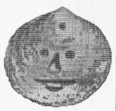
Carved shell from the Late Pliocene Red
Cragfonnation, England
As we begin Part I of Forbidden Archeology, we survey the history
and current state of scientific idcas about human evolution. Mainly
we are concerned with a double standard in how evidence is treated.
We identify two main bodies of evidence. The first (A) is
controvcrsial evidence that points to thc existence of anatomically
modern humans in the uncomfortably distant past. The sccond (B) is
evidence that can be taken to
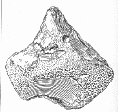
Pointed implemented from below the Red Crag.
This specimen is over 2.5 million years old.
support the now dominant vicw that modern humans evolved. in
Africa and perhaps elsewhere, fairly recently, about 100,000 years
ago.
After detailed study. we find that if the same standards for
judging evidence are applied equally to A and B, we must either
accept both A and B or reject them both. If we accept them both, we
have evidence placing anatomically modern human beings millions of
years in the past, coexisting with more apelike hominids. If we
reject them both, we deprive ourselves of the evidential grounds for
saying anything at all about human origins and antiquity.
Historically, many scientists once accepted the evidence in
category A. But a more influential group of scientists applied
standards of evidence more strictly to A than to B. So A was
rejected and B preserved. This differing application of standards
set up aknowledge filter" that obscures the real picture of human
origins and antiquity.
In the main body of Part I (Chapters 2-6), we look closely at the
vast amount of evidence that runs against current ideas on human
evolution. We tell in detail how this evidence has been suppressed,
ignored, or forgotten. even though it is as good in quality (and
quantity) as the evidence for currently accepted views. When we
speak of suppression of evidence. we are not referring to a satanic
plot by scientific conspirators bent on deceiving the public.
Instead. we are talking about an ongoing social process of knowledge
filtration . Certain categories of evidence simply disappear.
Crude Human Artifacts
Chapter 2 deals with anomalously old bones and shells showing cut
marks and signs of intentional breakage. To this day. scientists
regard bones and shells as an important category of evidence, and
many archeological sites are valued for this kind of evidence alone.
In the decades after Darwin introduced his theory. many
scientists discovered incised and broken animal bones and shells
suggesting that tool- using humans or near-humans lived in the
Pliocene Era (2 to 5 million years ago). the Miocene (5 to 25
million years ago).andevenearlier.lnanalyzingthese cut and broken
bones and shells, the discoverers carefully weighed and ruled out
alternative explanations—such as geological pressure or the work of
animals —before concluding that humans were responsible.
A striking example is a shell with a crude yet recognizably human
face carved on its outer surface. The shell was reported by
geologist H. Stopes to the British Association for the Advancement
of Science in 1881. According to standard views, humans capable of
the artistrv the shell displays did not arrive in Europe until
30,000 or 40,000 years ago. And even in their African homeland they
are not supposed to have shown up until some 100'000 years ago. Yet
the shell came from the Pliocene Red Crag formation in England, a
formation considered more than 2 million years old.
Concerning evidence of the kind reported by Stopes.
anthropologist Armand de Quatrefages wrote in his book Hommes
Fossiles et Hommes Saud vages (1884): "The objections made to the
existence of man in the Pliocene and Miocene seem habitually more
related to theoretical considerations than to direct observation."
Dawn Stones
The most rudimentary stone tools, the eoliths ("dawn stones"),
are the subject of Chapter 3.These implements, found in unexpectedly
old geological contexts, inspired protracted debate in the late
nineteenth and early twentieth centuries.

Left: Dorsal and ventral views of a stone
tool recovered in Portugal from a Tertiary forma- tion, over 2
million years old. Right: Anaccepted stonetool; lessthan 100,000
years old, from the Mousterian cultural stage of the European Late
Pleistocene. Both implements clearly display the following
features of intentional humanwork: (1)striking platforms, (2)
eraillures, (3) bulbs of percussion, and (4) parallelflake
removal.
For some, eoliths were not always easily recognizable as tools.
Eoliths are not symmetrical implements. Rather, they are natural
stone flakes with an edge chipped to make them suitable for a
particular task, such as scraping, cutting, or chopping. Often. the
working edge bears signs of use.
Critics said eoliths resulted from natural forces. Iike tumbling
in stream beds. But defenders of eoliths countered that natural
forces could not have made one-way chipping on just one side of a
working edge.

These implements from the Kent Chalk Plateau
were characterized as paleoliths by Sir John Prestwich. Prestwich
called the one on the left, from Bower Lane, "a roughly made
imp/enlent of the spearhead type."
In the late nineteenth century, Benjamin Harrison, an amateur
archeologist, found eoliths on the Kent Plateau in southeastern
England. Ceological evidence suggests that these eoliths were made
in the Middle or Late Pliocene. about 2 to 4 million ago. Among the
supporters of Harrison's eoliths were Sir John Prestwich, one of
England's most eminent geologists; Ray E. Lankester, a director of
the British Museum (Natural History); and Alfred Russell Wallace,
co-founder with Darwin of the natural-selection theory of evolution.
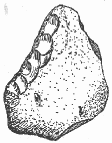
An eolith from the Kent
Plateau.
Although Harrison found most of his eoliths in surface deposits
of Pliocene gravel, he also found many below ground level. He also
found more advanced stone tools (paleoliths). Again. geological
evidence suggests that these were of similar Pliocene antiquity.
In the early part of the twentieth century, J . Reid Moir found
eoliths (and more advanced stone tools) in England 's Red Crag
formation. Moir was a fellow of the Royal Anthropological Institute
and president of the Prehistoric Society of East Anglia. The strata
in which he found the tools are dated at 2 to 2.5 million years old.
Moir found somc of the tools in the detritus beds beneath the Red
Crag. This indicates that they could have been made from 2.5 to 55
million years ago.
Moir's finds won support from a most vocal critic of eoliths,
Henri Breuil, then regarded as a preeminent authority on stone
tools. Another supporter was paleontologist Henry Fairfield Osborn,
of the American Museum of Natural History in New York. In 1923, an
international commission of scientists journeyed to England to
investigate Moir's main discoveries. The commission pronounced them
genuine. But in 1939, A. S. Barnes published an influential paper in
which he analyzed the angle of flaking on Moir's eoliths. Barnes
claimed his method could tell between human handiwork and flaking
from natural causes. On this basis, he dismissed all the eoliths he
studied, including Moir's, as products of natural forces. Since
then, scientists have used Barnes's method to deny the human
manufacture of many other stone tools. But in recent years,
stone-tool authorities have disputed Barnes's method and its blanket
use. This suggests that the European eoliths need to be looked at
again.
Significantly, early stone tools from Africa, such as those from
the lower levels of Olduvai Gorge, appear identical to the rejected
European eoliths. Yet the scientific communitv accents the Olduvai
tools without question.

Quartzite bifaces from the lower glacial till
(Level V) at Sheguiandah. Geologist John Sanford (1971) argued
these tools were at least 65,000 years old.
Those tools, of course, fall within, and help support, the
conventional places and times for human evolution.
But other eoliths of unexpected antiquity run into strong
opposition. Here is another example. In the 1950s, at Calico in
southern California, Louis Leakey found stone tools in strata dated
more than 200,000 years old. According to standard views, humans did
not enter such sub-Arctic regions of the New World until about
12,000 years ago. So mainstream scientists responded to Calico
predictably: the objects found there were natural products or not
really 200,000 years old, they said. But there the strata are, still
dated at 200,000 years. And though most of the Calico implements are
crude, some, including a beaked graver, are more advanced. They look
for all the world like genuine human artifacts.
More Recognizable Tools
In Chapter 4 we look at a category of implements we call "crude
paleoliths." In eoliths, chipping is confined to the working edge of
a naturally broken stone. But the makers of crude paleoliths
deliberately struck flakes from stone cores and then shaped the
flakes (and sometimes the cores) into more recognizable tools.
Among the crude paleoliths we look at are the tools found in the
late nineteenth century by Carlos Ribeiro, head of the Geological
Survey of Portugal. Ribeiro found these tools in Miocene strata, 5
to 25 million years old. At an international conference of
archeologists and anthropologists held in Lisbon, a committee of
scientists investigated one of the sites where Ribeiro had found
these implements. One scientist from the conference then found a
stone tool even more advanced than the better of Ribeiro's
specimens. It matched accepted Late Pleistocene tools, yet it was
firmly embedded in a Miocene conglomerate, in circumstances
confirming its Miocene antiquity.
Crude paleoliths were also found in Miocene formations at Thenay,
France. S. Laing, an English science writer, noted: "On the whole,
the evidence for these Miocene implements seems to be very
conclusive, and the objections to them have hardly any other ground
than the reluctance to admit the great antiquity of man."
At Aurillac, France, scientists also found crude paleoliths,
apparently of Miocene age. And at Boncelles, Belgium, A. Rutot
uncovered a large collection of paleoliths in Oligocene strata (25
to 38 million years old).
Implements of Modern Man
In Chapter 5 we examine advanced stone implements found in
unexpectedly old geologicai contexts. Given current estimates of
what Homo erecus or Homo habilis could do, the tools discussed in
Chapters 3 and 4 could conceivably be their work. But the implements
of Chapter 5 are certainly the work of anatomically modern humans.
Florentino Ameghino, a respected Argentine paleontologist, found
stone tools, broken mammal bones, a human vertebra, and signs of
fire in a Pliocene formation at Monte Hermoso, Argentina, in 1887.
He made numerous similar discoveries, attracting the eyes of
scientists around the world.

Left: A flint implement from an Early Miocene
formation at Thenay France. Right: An accepted implement from the
lower middle part of Bed II Oldulvai Gorge, Africa. The lower
edges of both specimens show roughly parallel flake scars
satisfying yhe requirements of L. Patterson (1983) for recognition
as objects of human manufacture.
In 1912, Ales Hrdlicka, of the Smithsonian Institution, pub!ished
a lengthy but not very reasonable attack on Ameghino's work.
Hrdlicka asserted that all of Ameghino's finds were from recent
Indian settlements.
In response, Carlos Ameghino, Florentino's brother, carried out
new investigations at Miramar, south of Buenos Aires. There he found
a series of stone implements, including bolas, and signs of fire. A
commission of geologists confirmed the position of the implements in
the Chapadmalalan formation, which modern geologists say is 3 to 5
million years old. Carlos also found at Miramar a stone arrowhead
firmly lodged in the femur of a Pliocene species of Toxodon, an
extinct South American mammal.
Ethnographer Eric Boman disputed Carlos Ameghino's finds but also
unintentionally helped confirm them. In 1920, Carlos Ameghino 's
collector, Lorenzo Parodi, found a stone implemen in the Pliocene
seaside barranca (cliff) at Miramar and left it in place. Bomar was
one of several scientists Ameghino invited to witness the
implement's extraction. After the implement (a bola stone) was
photographed and removed, another discovery was made.
"At my direction," wrote Boman, "Parodi continued to attack the
barranca with a pick at the same point where the bola stone was
discovered, when suddenly and unexpectedly, there appeared a second
stone ball.... It is more like a grinding stone than a bola." Boman
found yet another implement 200 yards away. Confounded. Boman could
only hint in his written report that the implements had been planted
by Parodi. While this might conceivably have been true of the first
implement, it is hard to explain the other two in this way. In any
case, Boman produced no evidence at all that Parodi, a long-time
employee of the Buenos Aires Museum of Natural History, had ever
behaved fraudulently.
Arrowheads and bolas, the kinds of implements found by Carlos
Ameghino at Miramar, are usually considered the work of modern man,
Homo sapiens s apiens. The Miramar finds, therefore, taken at face
value, show the presence of anatomically modern man in South America
over 3 million years ago. Interesting? In 1921 M. A. Vignati
discovered in the same Late Pliocene formation the fossil of a jaw
fragment, fully human.
If You Can't Bear the Evidence, Kill It

These stone bolas were extracted from the
Late Pliocene Chapadmalalan formation at Miramar, Argentina, in
the presence of ethnographer Eric Boman.
In the early 1950s, Thomas E. Lee of the National Museum of
Canada found advanced stone tools in glacial deposits at
Sheguiandah, on Manitoulin Island in northern Lake Huron.
GeologistJohn Sanford of Wayne State University proposed that the
oldest of these Sheguiandah tools were at least 65,000 years old and
might be as much as 125,000. For those adhering to standard views on
North American prehistory, such ages were unacceptable.

Stone tools found at Hueyatlaco, Mexico, a
site dated at about 250,000 years by a team from the United States
Ceological Survey.
Thomas E. Lee tells what happened next: "The site's discoverer
[Lee] was hounded from his Civil Service position into prolonged
unemployment; publication outlets were cut off; the evidence was
misrepresented by several prominent authors . . .; the tons of
artifacts vanished into storage bins of the National Museum of
Canada; for refusing to fire the discoverer, the Director of the
National Museum, who had proposed having a monograph on the site
published, was himself fired and driven into exile; official
positions of prestige and power were exercised in an effort to gain
control over just six Sheguiandah specimens that had not gone under
cover; and the site has been turned into a tourist resort....
Sheguiandah would have forced embarrassing admissions that the
Brahmins did not know everything. It would have forced the rewriting
of almost every book in the business. It had to be killed. It was
killed."
In the 1960s, anthropologists uncovered advanced stone tools at
Hueyatlaco, Mexico. Geologist Virginia Steen McIntyre and other
members of a team from the U.S. Geological Survey obtained for the
site's implement-bearing layers an age of about 250,000 years. This
challenges the whole standard picture of human origins. Men capable
of making the kind of tools found at Hueyatlaco are not thought to
have come into existence until some 100,000 years ago, in Africa.
Virginia Steen-Mclntyre had a hard time getting her dating study
on Hueyatlaco published. "The problem as I see it is much bigger
than Hueyatlaco," she wrote to Estella Leopold, associate editor of
Quaternary Research. "It concerns the manipulation of scientific
thought through the suppression of 'Enigmatic Data,' data that
challenges the prevailing mode of thinking. Hueyatlaco certainly
does that! Not being an anthropologist, I didn't realize the full
significance of our dates back in 1973, nor how deeply woven into
our thought the current theory of human evolution has become. Our
work at Hueyatlaco has been rejected by most archaeologists because
it contradicts that theory, period."
Such patterns of data suppression have a long history. In 1880,
J. D. Whitney, the state geologist of California, published a
lengthy review of advanced stone tools found in California gold
mines. The implements included spear points and stone mortars and
pestles. They were found deep in mine shafts, beneath thick
undisturbed layers of lava, informations that geologists now say are
from 9 million to more than 55 million years old. The finds, Whitney
wrote, pointed to the existence of human beings in North America in
very ancient times.
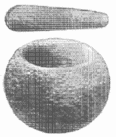
This mortar and pestle were found by J. H.
Neale, who removed them from a mine tunnel penetrating Tertiary
deposits (33-55 million years old) under Table Mountain, Tuolumne
County, California.
W. H. Holmes of the Smithsonian Institution, one of the most
vocal nineteenth-century critics of the California finds, responded:
"Perhaps if Professor Whitney had fully appreciated the story of
human evolution as it is understood today, he would have hesitated
to announce the conclusions formulated, not with standing the
imposing array of [supporting] testimony with which he was
confronted." In other words, if facts disagree with the favored
theory, then those facts, even an imposing array of them, must be
discarded.
Skeletons that Cause Problems
In Chapter 6 we review discoveries of anomalously old skeletal
remains, anatomically modern human. Perhaps the most interesting
case comes from Castenedolo, Italy. There in the 1880s, G.
Ragazzoni, a geologist, found fossil bones of several Homo sapiens
sapiens in layers of Pliocene sediment 3 to 4 million years old.
Critics typically respond that the bones must have been placed into
those Pliocene layers by fairly recent human burial. But Ragazzoni,
alert to this possibility, had carefully inspected the overlying
layers. He had found them undisturbed, with absolutely no sign of
burial.
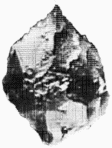
A beaked graver . . . a stone tool from
Calico in southern California, dated at about 200,000
years.
Modern scientists have used radiometric and chemical tests to
attach recent ages to the Castenedolo bones and other anomalously
old human skeletal remains. But these tests can be quite unreliable.
The carbon 14 test is especially shaky when applied to bones (such
as those from Castenedolo) that have lain in museums for decades.
Such bones are exposed to contamination that could make the test
yield abnormally young dates. To remove such contamination requires
rigorous purification techniques. Scientists failed to use those
techniques when, in 1969, they tested some Castenedolo bones and
found an age of less than a thousand years.
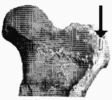
This toxodon tighbone (femur), with a stone
projectile point embedded in it, was discovered in a Pliocene
formation at Miramar, Argentina.
Although the carbon 14 date for the Castenedolo material is
suspect, it must still be considered relevant evidence. But it
should be weighed with the other evidence, including the original
stratigraphic observations of Ragazzoni, a professional geologist.
In this case, the stratigraphic evidence appears more persuasive.
Opposition on theoretical grounds to a human presence in the
Pliocene is not new. Speaking of the Castenedolo finds and others of
similar antiquity, the Italian scientist G. Sergi wrote in 1884: "By
means of a despotic scientific prejudice, call it what you will,
every discovery of human remains in the Pliocene has been
discredited."
A good example of such prejudice is provided by R. A. S.
Macalister. In 1921, in a textbook on archeology, he wrote: "The
acceptance of a Pliocene date for the Castenedolo skeletons would
create so many insoluble problems that we can hardly hesitate in
choosing between the alternatives of adopting or rejecting their
authenticity."
This supports the main point we are making in Forbidden
Archeology: the scientific community has a knowledge filter that
screens out unwelcome evidence. This process of knowledge filtration
has been going on for well over a century, and it continues right up
to the present day.
Java Man
In Part 11 of Forbidden Archeology, we survey the body of
accepted evidence generally used to support the now-dominant ideas
about human evolution.
Chapter 7 focuses on the discovery of Pithecanthropus erectus by
Eugene Dubois in Java during the last decade of the nineteenth
century. Historically, the Java man discovery marks a turning point.
Until then, there was no clear picture of human evolution to be
upheld and defended. So a good number of scientists, most of them
evolutionists, were actively considering the evidence that
anatomically modern humans lived in the Pliocene and earlier. But
with the discovery of Java man, now classified as Homo erectus, the
long-awaited missing link turned up in the Middle Pleistocene, only
800,000 years ago. As Java man won acceptance, the evidence for a
human presence in more ancient times slid into disrepute.

This anatomically modern human skull was
found in 1880, at Castened olo, Italy. The stratum from which it
was taken is assigned to the Astian stage of the Pliocene.
According to modern authorities the Astian belongs to the Middle
Pliocene, which would give the skull an age of 3-4 million
years.
This evidence was not conclusively tossed out. Instead,
scientists stopped talking and writing about it. It didn't fit with
the idea that apelike Java man was a genuine human ancestor.
Interestingly enough, modern researchers have reinterpreted the
original Java man fossils. The famous bones reported by Dubois were
a skullcap and femur. Though they were found more than 45 feet
apart, in a deposit filled with bones of many other species, Dubois
said they belonged to the same individual. But in 1973, M. H. Day
and T. I. Molleson determined that the femur found by Dubois is
different from other Homo erectus femurs and in fact matches
anatomically modern human femurs. This led Day and Molleson to
propose that the femur was not connected with the Java man skull.

Pilhecanlhropus skullcap discovered by Eugene
Dubois in 1891 in Java.
As far as we can see. this means we now have an anatomically
modern human femur and a Homo erectus skull in a Middle Pleistocene
layer considered 800,000 years old. This gives further evidence that
anatomically modern humans coexisted with more apelike creatures in
unexpectedly remote times. According to standard views, anatomically
modern man arose just 100,000 years ago in Africa. Of course, one
can always propose that the modern human femur somehow got buried
recently into the Middle Pleistocene beds. But the same could also
be said of the skull.
In Chapter 7 we consider the many discoveries of Java Homo
erectus reported by G. H. R. von Koenigswald and other researchers.
Almost all these bones were surface finds, their true age doubtful.
Nevertheless, scientists have assigned them Middle and Early
Pleistocene dates obtained by the potassium-argon method. The
potassium-argon method is used to date layers of volcanic rock, not
bones. Because the Java Honlo erectus fossils were found on the
surface and not below intact volcanic layers, assigning them
potassium-argon dates is misleading.
The Piltdown Hoax
The subject of Chapter 8 is the infamous Piltdown hoax. Early in
this century, Charles Dawson, an amateur collector, found pieces of
a human skull near Piltdown, England. Scientists such as Sir Arthur
Smith Woodward of the British Museum and Pierre Teilhard de Chardin
later took part with Dawson in excavations that uncovered an apelike
jaw, along with several mammalian fossils of appropriate antiquity.
Dawson and Woodward, believing that the human like skull and apelike
jaw came from a human ancestor in the Early Pleistocene or Late
Pliocene, announced their discovery to the scientific world. For the
next four decades, Piltdown man was accepted as genuine and was
integrated into the human evolutionary lineage.
In the 1950s, J. S. Weiner, K. P. Oakley, and other British
scientists exposed Piltdown man as an exceedingly clever hoax,
carried out by someone with great scientific expertise. Some blamed
Dawson, Teilhard de Chardin, or Sir Arthur Smith Woodward. Others
have accused Sir Grafton Eliot Smith, a famous anatomist; William
Sollas of the geology department at Cambridge; and Sir Arthur Keith
of the Hunterian Museum of the Royal College of Surgeons.
J. S. Weiner himself noted: "Behind it all we sense, therefore, a
strong and impelling motive.... There could have been a mad desire
to assist the doctrine of human evolution by furnishing the
'requisite' 'missing link.' "
Piltdown shows that in addition to the general process of
knowledge filtra- tion in paleoanthropology, there are instances of
deliberate fraud.
Finally, there is substantial, though not incontrovertible,
evidence that the Piltdown skull, at least, was a genuine fossil.
The Piltdown gravels in which it was found are now thought to be
75,000 to 125,000 years old. An anatomically modern human skull of
this age in England would be considered anomalous.
Evidence from China
Chapter 9 takes us to China. There in 1929 Davidson Black
reported the discovery at Zhoukoudian (formerly Choukoutien) of the
Peking man fossils. These specimens of Peking man, now classified as
Homo erecus, were lost to science during the Second World War.

Thighbone found by Eugene Dubois at Trinil,
Java. Dubois attributed it to Pithecanthropus
erectus.
In addition to Peking man, many more hominid finds have been made
in China. The dating of these hominids is problematic. They occur at
sites along with fossils of mammals broadly typical of the
Pleistocene. In reading various reports, we noticed that to date
these sites more precisely, scientists routinely used the morphology
of the human remains.
For example,at Tongzi, South China, Homo sapiens fossils were
found with fossils of mammals. Paleontologist Qiu Zhonglang said:
"The fauna suggests a Middle-Upper Pleistocene range, but the
archeological [i.e., human] evidence is consistent with an Upper
Pleistocene age." Therefore, using what we call morphological
dating, Qiu assigned the site to the Upper Pleistocene - and the
human fossils with it. But our review of the Tongzi faunal evidence
shows species of mammals that became extinct thousands of years
earlier, at the end of the Middle Pleistocene. This indicates that
the Tongzi site, and the human fossils, are at least 100,000 years
old. Additional faunal evidence suggests a maximum age of about
600,000 years.
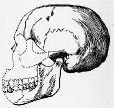
Restoration of the Piltdown skull and jaw by
Dawson and Woodward.
The practice of morphological dating distorts the fossil record.
In effect, scientists simply arrange human fossils to fit a favored
evolutionary sequence, setting the evidence of other species aside.
If one goes by the true probable date ranges for the Chinese
hominids, one finds that various grades of Homo erectus and early
Homo sapiens may have coexisted with anatomically modern man in the
middle Middle Pleistocene, during the time of Peking man.
Extinct Men Still Alive?
In Chapter 10 we consider the possible coexistence of primitive
hominids and anatomically modern humans not only in the distant past
but in the present. Over the past century, scientists have gathered
evidence suggesting that humanlike creatures resembling supposedly
extinct ancestral species of man are living in various wilderness
areas of the world. In North America these creatures are known as
Sasquatch. In Central Asia they are called Almas. In Africa, China,
Southeast Asia, Central America, and South America, they are known
by other names. Some researchers use the general term "wild-men" to
include them all. Scientists and physicians have reported seeing
live wildmen, dead wildmen, and footprints. They have also
catalogued thousands of reports from historical records and from
ordinary people who say they have seen wildmen.
Myra Shackley, a British anthropologist, wrote to us: "Opinions
vary, but I guess the commonest would be that there is indeed
sufficient evidence to suggest at least the possibility of the
existence of various unclassified manlike creatures, but that in the
present state of our knowledge it is impossible to comment on their
significance in any more detail. The position is furthercomplicated
by misquotes, hoaxing, and lunatic fringe activities. but a
surprising number of hard-core anthropologists seem to be of the
opinion that the matter is very worthwhile investigating."
Australopithecus
Chapter 11 takes us to Africa. We describe in detail the cases
mentioned in the first part of this introduction (Reck's skeleton,
the Laetoli footprints, and so on). These provide evidence for
anatomically modern humans in the Early Pleistocene and Late
Pliocene.
We also examine the status of Australopithecus.
Mostanthropologists say Australopithecus was a human ancestor with
an apelike head, a humanlike body, and a humanlike bipedal stance
and gait. But other researchers make a convincing case for a
radically differentviewofAustralopithecus. Physical anthropologist
C. E. Oxnard wrote in his book Uniqueness and Diversity in Human
Evolution (1975): "Pendingfurther evidence we are left with the
vision of intermediately sized animals, at home in the trees,
capable of climbing, performing degrees of acrobatics, and perhaps
of arm suspension." In a 1975 article in Nature, Oxnard found the
australopithecines to be anatomically similar to orangutans and
said, "It is rather unlikely that any of the Australopithecines . .
. can have any direct phylogenetic link with the genus Homo."
Inspired by the Vedic Writings
Some might question why we would put together a book like
Forbidden Archeology unless we had some underlying purpose. Indeed,
there is one.
Richard Thompson and I are members of the Bhaktivedanta
Institute, a branch of the International Society for Krishna
Consciousness that studies the relationship between modern science
and the world view expressed in the Vedic literature. The institute
was founded by our spiritual master, His Divine Grace A. C.
Bhaktivedanta Swami Prabhupada. He encouraged us to critically
examine the prevailing account of human origins and the methods by
which it was established.
From the Vedas we derive the idea that the human race is of great
antiquity. To conduct research into scientific literature on human
antiquity, we put the Vedic idea into the form of a theory that
various humanlike and apelike beings have coexisted for a long time.
That our theoretical outlook is derived from the Vedic literature
should not disqualify it. Theories can come from many sources - a
private inspiration, previous theories, a movie, a suggestion from a
friend, and so on. What matters is not a theory's source but its
ability to account for observations.
For more information on either book or to correspond with the
authors, call (800)443-3361, send e-mail to ghi@freenet.ufl.edu, or write:
Govardhan Hill Publishing,
P.O. Box 52, Badger, CA 93603.
News (#958 of 1004):
 The
Latter Days by James Crenshaw (Sun Aug 15 1993)
The
Latter Days by James Crenshaw (Sun Aug 15 1993)
 Aryan Invasion by N.S. Rajaram (Thu Aug 26 1993)
Aryan Invasion by N.S. Rajaram (Thu Aug 26 1993)
 Homepage
Homepage
Veda
& Dharma : Dharma ∑ Vedas, An
Overview ∑ What is
Vedic Literature? ∑ Veda
Articles ∑ Forbidden Archeology ∑ Scripture
Excerpts ∑ Nine
Questions About Hinduism ∑ God and
Gods of Hinduism
Related
Pages:
The
Meier Case & Its Spirituality - James W. Deardorff
The
Alien Question: An Expanded Perspect.. - Neil Freer
Out of
Body Experience FAQ - Jouni A. Smed
UFO
Mini FAQ - Charles McGrew
alt.alien.visitors
Frequently Asked Ques..
Discussion
of B. K. Smith's "Classifying.. - Vidhyanath Rao
Abduction
and Present Psychology: Dr. Br.. - Marc Whitford
Aryan
Invasion - N.S. Rajaram
Comparative
Cosmology - Akif Manaf J., Ph.D...
The
Myth of the Aryan Invasion of India - David Frawley
The
Prophets Conference 1997: Dr. Edgar .. - Axiom